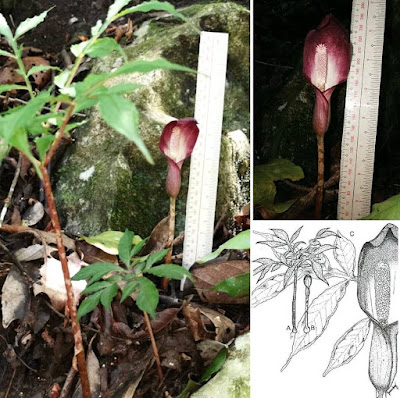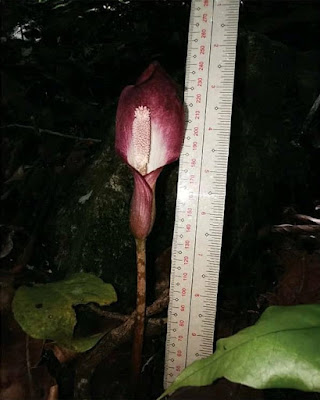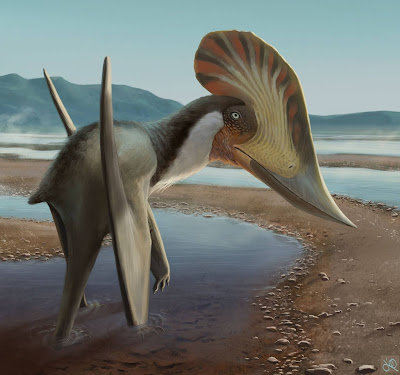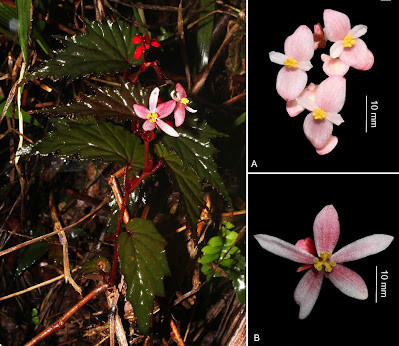[Most Recent Entries] [Calendar View]
Wednesday, September 15th, 2021
| Time | Event | ||||||
| 2:06a | [Botany • 2021] Amorphophallus minimus (Araceae: Thomsonieae) • A New Species from the Montane Forest of Nueva Ecija, Luzon island, Philippines
Abstract Amorphophallus minimus (Araceae) is herein described and illustrated as a new species from the montane forest of Nueva Ecija, Luzon island, Philippines. A. minimus has an overall resemblance to Amorphophallus palawanensis Bogner and Hett., however, it is easily distinguished by having a club-shaped and colliculate appendix that is contiguous with the male zone, oblate stamens (2 per flower), presence of leaf bulbils, and its overall small dimensions. Amorphophallus minimus is currently the only species in the Philippines found to inhabit a montane forest ecosystem. Keywords: Caraballo Mountain Range, lichen mimicry, Malesia, staminodes, subg. Amorphophallus, Thomsonieae
Amorphophallus minimus R.Bustam., C. Claudel and M.N.Tamayo, sp. nov. subg. Amorphophallus Etymology: The epithet ‘minimus' is derived from the Latin word ‘minima' meaning small. The name depicts the relatively small size of both the vegetative and flowering phase of the new species. Rene Alfred Anton Bustamante, Cyrille Claudel, John Charles A. Altomonte, Leonardo C. Udasco and Maverick N. Tamayo. 2021. Amorphophallus minimus (Araceae), A New Species from the Montane Forest of Nueva Ecija, Luzon island, Philippines. Nordic Journal of Botany. DOI: 10.1111/njb.03251 | ||||||
| 3:22a | [Paleontology • 2021] Kariridraco dianae • A New Azhdarchoid Pterosaur from the Lower Cretaceous of Brazil and the Paleobiogeography of the Tapejaridae
The Tapejaridae were an apparently worldwide distributed clade of edentulous pterosaurs, being a major component of several Lower Cretaceous terrestrial faunas. Despite their distribution across Gondwana and Laurasia, the oldest tapejarid remains were found in Barremian units from Europe, what led to the assumption that the clade originated in Eurasia and later dispersed southwards. Here we present a new tapejarid pterosaur species (Kariridraco dianae gen. et sp. nov.) from the Lower Cretaceous Romualdo Formation of Brazil. The holotype (MPSC R 1056) comprises an incomplete, three dimensionally preserved skull, lower jaw, and cervical vertebrae. It shows a unique combination of features such as unusually tall and comparatively short nasoantorbital fenestrae, as well as a premaxillary crest forming an angle of about 45° with respect to main skull axis. Phylogenetic analyses recover the new taxon as a Tupuxuara-related Thalassodrominae, a clade of early-diverging tapejarids that were apparently indigenous to central Gondwana. The inclusion of the new taxon in current phylogenetic frameworks, in addition to similarity cluster analyses of Early Cretaceous tapejarid-bearing pterosaur faunas, indicate Gondwana as the most parsimonious origin center for Tapejaridae, and show that pterosaur communities were affected by large scale tectonic-driven vicariant events. Key words: Pterosauria, Azhdarchoidea, phylogeny, biogeography, Cretaceous, Romualdo Formation, Araripe Basin, Brazil. Pterosauria Kaup, 1834 Pterodactyloidea Plieninger, 1901 Azhdarchoidea Nesov, 1984 (sensu Unwin 2003) Tapejaridae Kellner, 1989 Thalassodrominae Kellner and Campos, 2007 Genus Kariridraco nov. Etymology: After the Kariris, former indigenous people that lived in the area of the Araripe Plateau, combined with the Latin draco, dragon. Type species: Kariridraco dianae gen. et sp. nov., Kariridraco dianae gen. et sp. nov. Etymology: In reference to Diana Prince, alter ego of the DC fictional character Wonder Woman. Diagnosis.— Kariridraco dianae gen. et sp. nov. differs from all other pterosaurs for the following combination of characters (characters marked with * represent autapomorphies): presence of a subtle jugal shelf; comparatively short and tall nasoantorbital fenestra; premaxillary crest forming an angle of about 45° with respect to the maxilla*; lacrimal with an anteriorly-directed deep concavity*, and a single elliptic lateral pneumatic foramen in the left lateral surface of cervical IV centrum. Conclusions: Kariridraco dianae gen. et sp. nov. (Fig. 11) has a set of diagnostic features that distinguishes it from other azhdarchoid pterosaurs, such as the presence of a concavity in the upper portion of the lacrimal and an angle of about 45° between the maxilla and the premaxillary crest. Kariridraco dianae gen. et sp. nov. was consistently recovered as a thalassodromine tapejarid, closely related to the well-known genus Tupuxuara. Our assessment of tapejarid paleobiogeography recovered Gondwana as the most parsimonious origin center for the Tapejaridae, also suggesting that, similarly to strictly terrestrial animals, pterosaur distribution is marked by tectonic-driven provincialism. Gabriela M. Cerqueira, Mateus A.C. Santos, Maikon F. Marks, Juliana M. Sayão, and Felipe L. Pinheiro. 2021. A New Azhdarchoid Pterosaur from the Lower Cretaceous of Brazil and the Paleobiogeography of the Tapejaridae. Acta Palaeontologica Polonica. in press. DOI: 10.4202/app.00848.2020 | ||||||
| 9:28a | [Botany • 2021] Begonia olganunezae (Begoniaceae, section Petermannia) • A New Begonia Species discovered in the Province of Bukidnon [Taxonomy of the Genus Begonia in Mindanao, Philippines I]
Abstract A new species, Begonia olganunezae from the mountains of Bukidnon province, southern Philippines is herein described and illustrated. It is morphologically allied to B. affinis and B. bangsamoro in having terminal inflorescences and staminate flowers with 4 tepals but differs significantly in having lanceolate stipules, and glabrous ovary and capsule. A detailed description, comparison with its allied species, colour plate, notes on phenology, distribution, and a provisional IUCN conservation assessment are provided below. Keyword: Begonia affinis, Begonia bangsamoro, biodiversity, conservation, endemic, Southeast Asia, Plant Taxonomy
Begonia olganunezae Naive & Cababan, sp. nov. Section Petermannia (Klotzsch) de Candolle Type: PHILIPPINES. Mindanao, Bukidnon, Valencia City, Barangay Lourdes, elev. 1523 m, 10 June 2021, M.A. Cababan 3 (holotype PNH [PNH258562]; isotypes HNUL [HNUL0020800], Bukidnon State University Herbarium). Diagnosis: Begonia olganunezae is morphologically allied to B. affinis Merr. and B. bangsamoro D.P.Buenavista, Pranada & Y.P.Ang in having terminal inflorescences and staminate flowers with 4 tepals. The new species differs significantly to B. affinis in having a sparsely strigose stem, lanceolate stipules, longer, sparsely to densely strigose petiole, narrowly ovate to ovate leaves with 7–8 majour veins, and glabrous ovary. It differs from B. bangsamoro in having lanceolate, glabrous stipules with cuspidate apex, staminate flowers with broadly ovate, rounded apex outer tepals and canaliculate inner tepals, and glabrous ovary. Distribution and habitat: Endemic to Mindanao, southern Philippines (Fig. 3). So far, this species was found and documented from its type locality i.e., Barangay Lourdes, Valencia City, Bukidnon. In December 2014, the species was documented in Mt. Kitanglad Range Natural Park, Sitio Kalanganan, San Vicente, Baungon, Bukidnon province and was erroneously identified as Begonia incisa D.C. (Pelser et al., 2011). The species was found growing as terrestrial under a close to semi-open canopy in the montane forest with a cool environment between an elevation of 1000 to 1600 m asl. Etymology: The species is named in honour of Professor Dr. Olga M. Nuñeza, an eminent professor and scientist in Mindanao State University - Iligan Institute of Technology (MSU-IIT) to recognize her efforts in documenting, studying, and conserving the flora and fauna of Mindanao while mentoring the next generation of scientists, including the first author. Mark Arcebal K. Naive and Mc Arthur Cababan. 2021. Taxonomy of the Genus Begonia (Begoniaceae) in Mindanao, Philippines I: Begonia olganunezae, A New Begonia section Petermannia Species discovered in the Province of Bukidnon. Taiwania. 66(4); 433-438. DOI: 10.6165/tai.2021.66.433 |
| << Previous Day |
2021/09/15 [Calendar] |
Next Day >> |



















